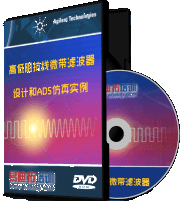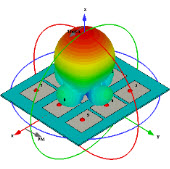question about surrounding space in CST MWS
HI,
I can't completely get ur words..do u mean the background materials? or the distance between the model and bounding box?
yeah,I mean the Surrounding space frame located in the dialog box of background properties.How should I enter the values of the parameters like Xlow,Ylow,Zlow.......Is Surrounding space considerated as the calculation area?
Default is zero, and works well for many cases, which means you do not need to change anything at all in many cases. However you can also change the value so that you see different size of the calculation box. The size of course impacts the calculation. For instance, if you have a much smaller size than default, then I think you will clearly see the difference. How to choose the appropriate size really depends. For instance, some people believe that the margin should be no less than quarter wavelength. To sum up, the more simulations you run, the more experience you will gain.
lower X distance 就是把你建的模型X轴的负方向增加background properties,其他的也是一样的理解,upper X distance 就是X正方向喽。为什么有这个设置呢,这也是考虑模型的外部环境,比如说CST平面器件那个例子,X Y Z的边界条件都是PEC, 此时设置了upper X distance 却设置5倍的介质板的厚度,我的理解就是在上方加了五倍介质板的真空。因为很多东西它是放在PEC的金属盒子里,但是顶面又不是直接和PEC接触。是的,增加了Surrounding space ,你就可以看到一个盒子框了,那个就是要计算的区域。
最近小编们,好像不怎么回帖了?
对了 你怎么不看帮助啊 我靠 英文这么 好 看的话不费劲啊
Surrounding space frame:
Apply in all directions: If this checkbox is activated, the value in lower X distance is applied in all directions. The remaining input fields are grayed out. Therefore, you do not need to enter the same value six times if it is the same for all directions.
Lower X / Upper X / Lower Y / Upper Y / Lower Z / Upper Z distance: This dialog group can be used to add some extra space around your structure. An open boundary, in particular, requires this extra space to operate properly. All numbers must be positive.
I did read the documents concerning the Surrounding space which does not clarifies the different results due to the different surrounding space.
I tried to expand the surrounding space and run the simulation again. But I got the same results except that the simulation time was longer compared with the former programming
Oh làlà, c’est pas normal
Thanks for everyone' explication
Does anyone know the reason why "I got the same results except that the simulation time was longer compared with the former programming "?
surrounding space就是模型的“最边缘处”和boundary box的距离,如果是0的话,除了"open add space"以外,其它边界会“紧贴”模型(相当于外接六面体)。
假设有一个模型,网格划分已经“合适”了,这时如果稍微增大surrounding space的数值,会稍微增大整个计算区域(网格数目增大),同时又不影响模型细节处的网格划分,这样仿真结果不会有明显改变但仿真时间会延长(要计算的网格多了)。
对以上的猜测,可以看一下solver logfile,excitation time应该保持不变。
[quote]引用第9楼hefang于2011-05-24 23:25发表的 回 8楼(雨后的天) 的帖子 :
surrounding space就是模型的“最边缘处”和boundary box的距离,如果是0的话,除了"open add space"以外,其它边界会“紧贴”模型(相当于外接六面体)。
假设有一个模型,网格划分已经“合适”了,这时如果稍微增大surrounding space的数值,会稍微增大整个计算区域(网格数目增大),同时又不影响模型细节处的网格划分,这样仿真结果不会有明显改变但仿真时间会延长(要计算的网格多了)。
对以上的猜测,可以看一下solver logfile,excitation time应该保持不变。
Thank you very much
刚开始我以为和hfss一样要加个空气盒子所以,我直接加的四分之一波长。然后算起来sb了,时间长得要死。
还好看到了这个帖子。
大家说了这么多,好像还是只说了区别,没说到底为什么
求远场可能好了解一些,但是求模型内部的电场或者电流分布什么的,有什么影响呢?
俺英文不好。只能看。说就算了
你觉得9楼的解释可以接受吗?
试验了半天,如果网格设置合理,确实就不变了。这几天帮别人看了个东西,设置这个距离不同仿真结果相差很大,看来还是有问题,谢谢啦
相关文章:
- 如何设置CST中的surrounding space (05-08)
- CST中surrounding space大小 (05-08)
- 问下,CST中边界open, open-addspace,peroidic,unit-cell这几个边界条件有啥区别啊? (05-08)
- 仿真频率段不同,open(addspace)距离不同。结果好像也有差异。 (05-08)
- 关于CST MWS open和open(add space) (05-08)
- 关于cst2012边界条件open和open(add space)影响 (05-08)











